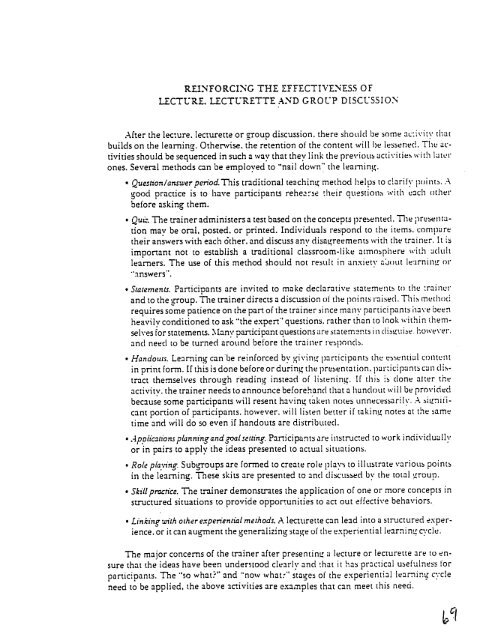Qn VATW Lk WAw LwUiWE WWW M - (PDF, 101 mb) - USAID
Qn VATW Lk WAw LwUiWE WWW M - (PDF, 101 mb) - USAID
Qn VATW Lk WAw LwUiWE WWW M - (PDF, 101 mb) - USAID
Create successful ePaper yourself
Turn your PDF publications into a flip-book with our unique Google optimized e-Paper software.
REINFORCING THE EFFECTIVENESS OF<br />
LECTURE. LECTURETTE AND GROUP DISCUSSION<br />
After the lecture. lecturette or group discussion. there should be some a:.ivitv th<br />
builds on the learning. Otherise. the retention of the content will be lessened. The activities<br />
should be sequenced in such a way that they link the previous,acti-'ities with later<br />
ones. Several methods can be employed to "nail down'" the learning.<br />
* Question/answerperiod.This traditional teaching method helps to clarify points. A<br />
good practice is to have participants rehearse their question., with each other<br />
before asking them.<br />
SQuLz. The trainer administers a test based on the concepts presented. The presentation<br />
may be oral, posted. or printed. Individuals respond to the items. compare<br />
their answers with each dther. and discuss any disagreements with the trainer. It is<br />
important not to establish a traditional classroom-like atmosphere with adult<br />
learners. The use of this method should not result in anxiety ai()ut le'irnin or<br />
"'answers".<br />
*Statements. Participants are invited to make declarative statements to the trainer<br />
and to the group. The trainer directs a discussion of the points raised. Thi.s method<br />
requires some patience on the part of the trainer since many participants have been<br />
heavily conditioned to ask "the expert" questions. rather than to look within themselves<br />
for statements. Many par-ticipant questions are statem2nts in his~uie, however.<br />
and need to be turned around before the trainer responds.<br />
"Handouts. Learning canbe reinforced by givinq participants the essential Content<br />
in print form. If this is done before or during the presentation. parzicipants can distract<br />
themselves through reading instead of listening. If this is clone alter the<br />
activity, the trainer needs to announce beforehand that a handout will be provided<br />
because some participants will resent having taken noteS unnecessarily. A sitni'icant<br />
portion of participants. however, will listen better if taking notes at the same<br />
time and will do so even if handouts are distributed.<br />
*Appiicationsplanningandgoalsetting. Participants are instructed to work individually<br />
or in pairs to apply the ideas presented to actual situations.<br />
"Role playing.Subgroups are formed to create role plays to illustrate various points<br />
in the learning. These skits are presented to and discussed by the total g.roup.<br />
*Skillpractice.The trainer demonstrates the application of one or more concepts in<br />
structured situations to provide opportunities to act out effective behaviors.<br />
*Linkingtrithother experientialmethods. A lecturette can lead into a structured experience.<br />
or it can augment the generalizing stage of the experiential learning c3cle.<br />
The major concerns of the trainer after presentin, a lecture or lecturette are to ensure<br />
that the ideas have been understood clearly and that it has practical usefulness for<br />
participants. The "so what?" and "now what." stages of the experiential learning cvcle<br />
need to be applied, the above activities are examples that can meet this need.

















